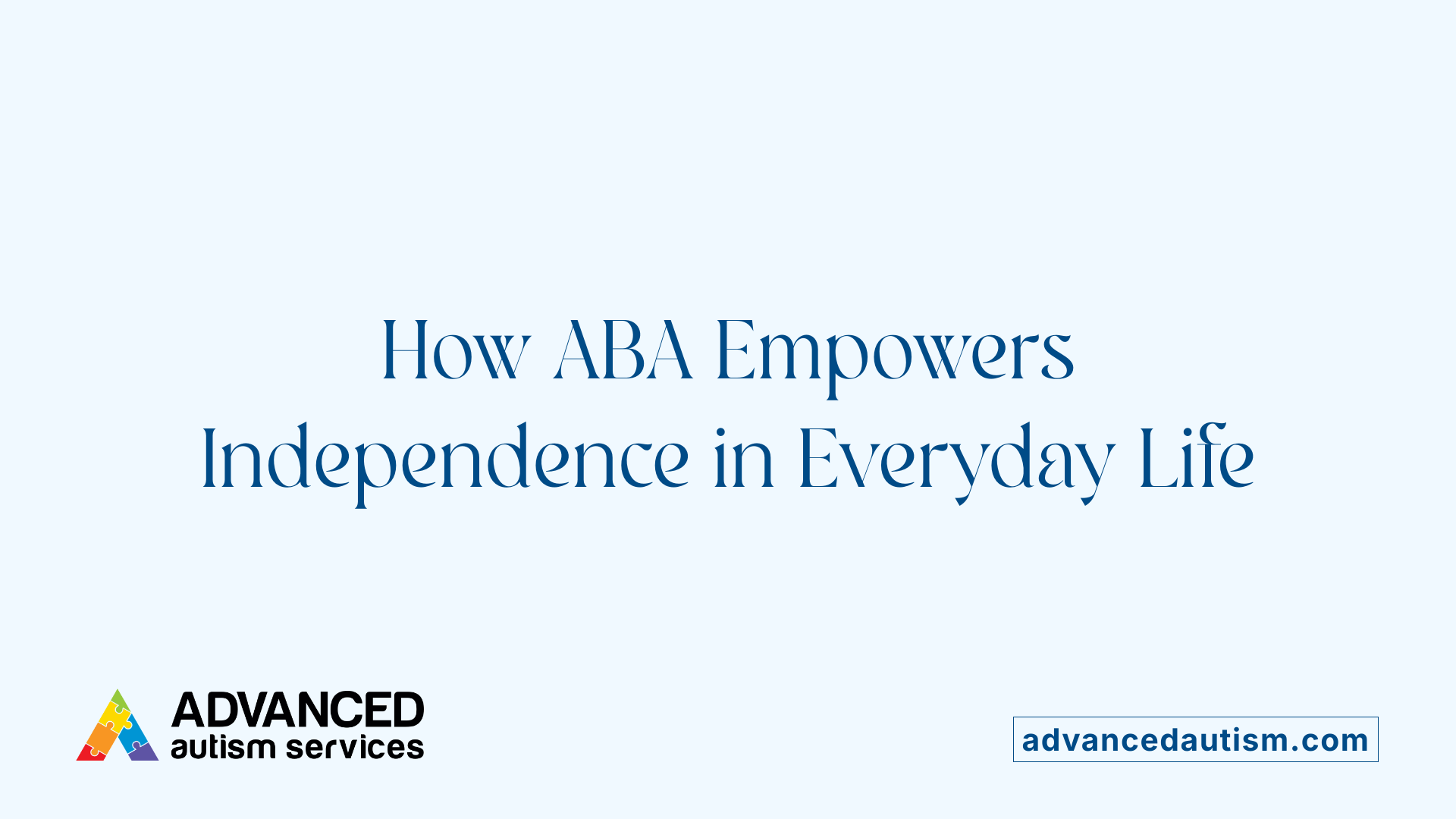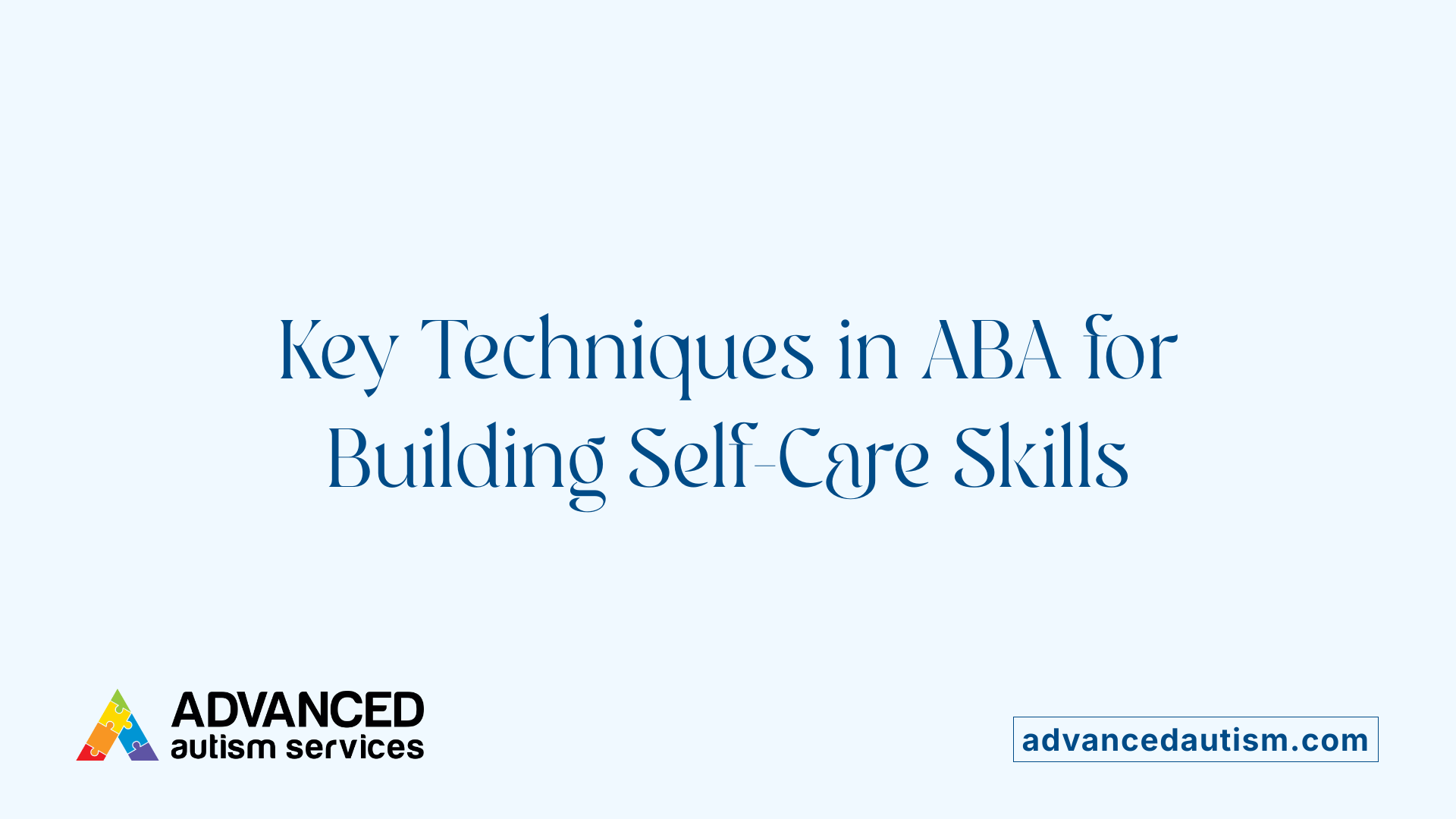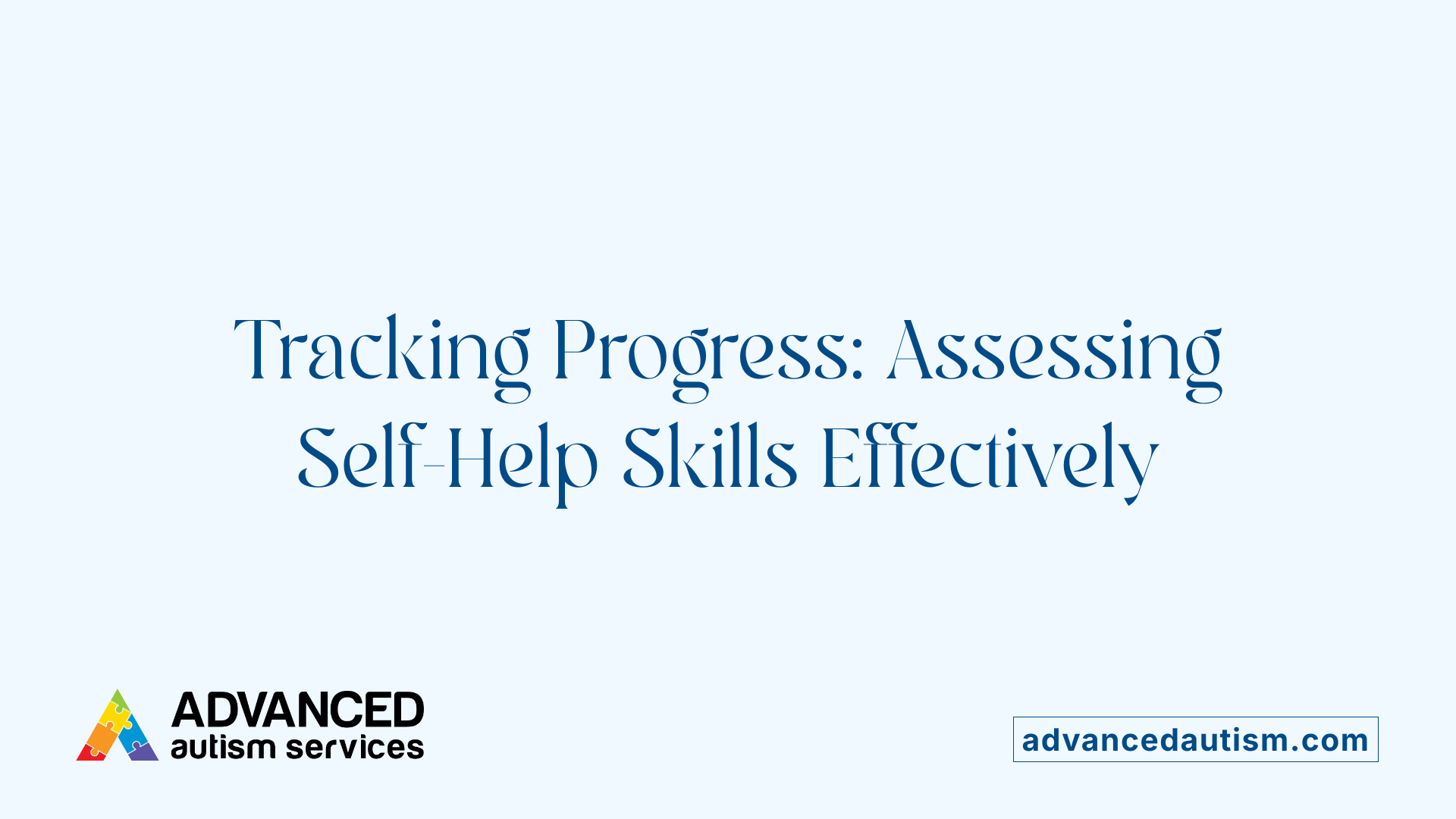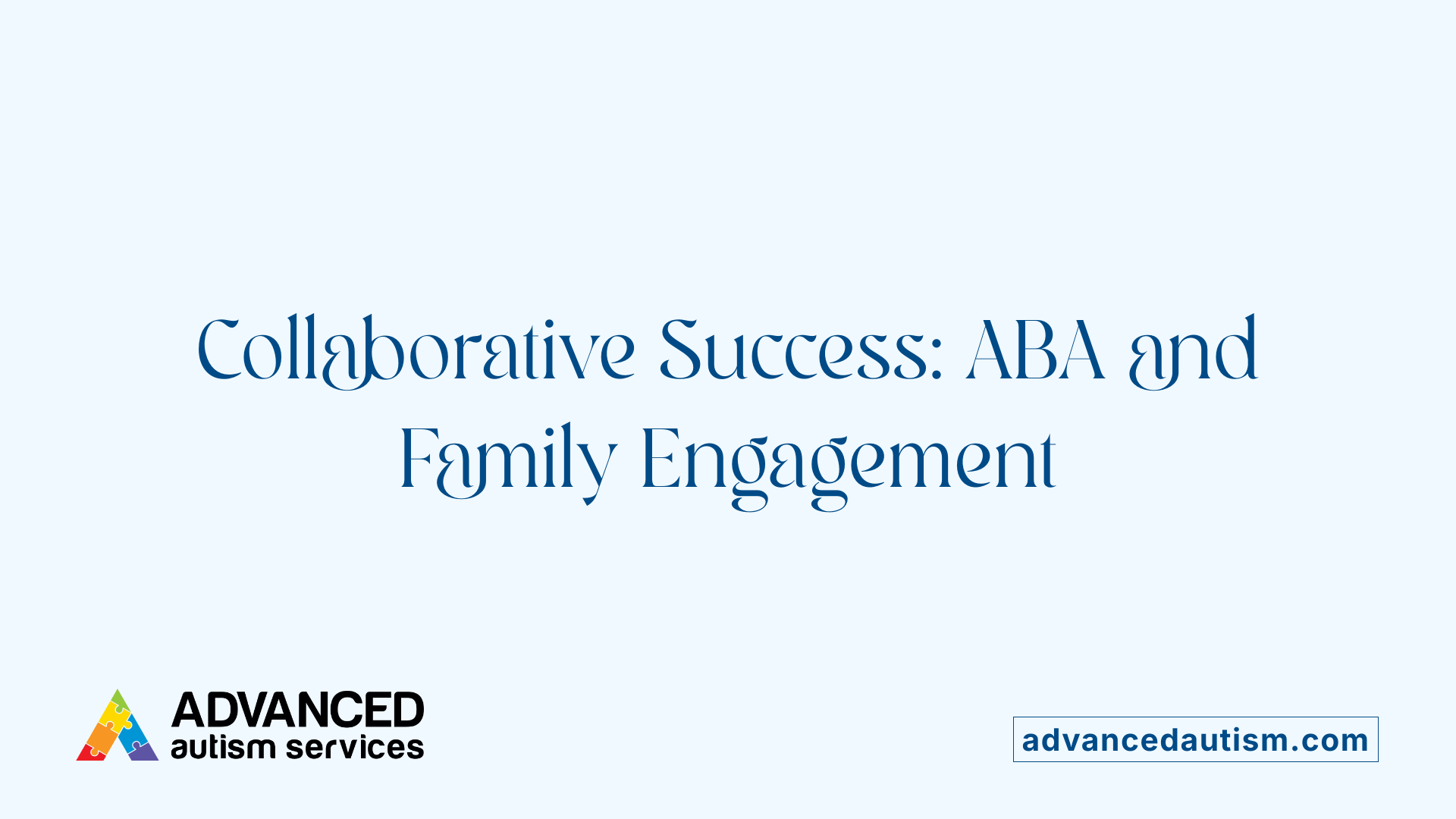ABA Therapy and Self-Help Skills
Building Independence: The Role of ABA in Cultivating Self-Help Skills
Understanding ABA and Its Impact on Daily Living
Applied Behavior Analysis (ABA) is a scientifically proven, flexible therapeutic approach that plays a vital role in helping individuals, especially those with autism, gain essential self-help and daily living skills. From personal hygiene to household chores, ABA’s structured techniques foster independence and improve overall quality of life, enabling individuals to participate more fully in their communities.
The Foundations of ABA Therapy and Its Goals

What is ABA therapy, and how does it support the development of self-help skills?
Applied Behavior Analysis (ABA) is an evidence-based approach grounded in the science of learning and behavior. It is widely used to support children with autism and other developmental challenges. ABA therapy works by understanding how behavior is influenced by antecedents (what happens before the behavior) and consequences (what happens afterward). This understanding allows practitioners to modify environments and teach new skills effectively.
In support of self-help skills, ABA involves breaking down complex routines into small, manageable steps—a process known as task analysis. For example, dressing or brushing teeth is divided into stages, enabling children to learn each step thoroughly before moving to the next. Visual supports like picture schedules, activity charts, and labels further reinforce routines, making it easier for individuals to understand and complete tasks independently.
Positive reinforcement, a core element of ABA, motivates children by rewarding desirable behaviors, increasing the likelihood of their repetition. Techniques such as prompting—where assistance is provided to encourage the desired action—and prompt fading—gradually reducing help—help children develop independence.
ABA programs are customized based on detailed assessments made by Board-Certified Behavior Analysts (BCBAs). These evaluations identify each child's current skills, preferences, and needs, guiding personalized intervention plans. The therapy aims not only at teaching specific self-help skills like dressing, grooming, eating, and toileting but also at promoting communication, social interaction, and self-regulation.
By fostering these skills within a structured, encouraging environment, ABA helps children become more autonomous and confident in their daily lives. The ultimate goal is to enable individuals to participate fully in routines at home, school, and community settings, improving their overall quality of life.
How does ABA therapy support individuals in gaining self-help skills, especially for those with autism?
ABA therapy facilitates the acquisition of self-help skills through systematic and structured teaching methods. Initially, a detailed assessment helps identify the child's current abilities and specific needs, which guides the creation of individualized goals.
One of the primary strategies is task analysis, where complex skills are broken into smaller steps. For instance, learning to brush teeth involves steps like picking up a toothbrush, applying toothpaste, brushing, rinsing, and drying. Each step is taught and reinforced independently, then combined into a complete routine.
Visual supports are particularly beneficial for individuals with autism. Picture schedules, labels, and visual cues help clarify expectations and provide visual prompts, reducing confusion and promoting independence.
Prompting techniques, including physical prompts (guiding the child's hand), verbal cues, and model demonstrations, assist children in performing each step. As skills improve, prompts are gradually faded, encouraging the child to perform tasks more independently.
Reinforcement plays a vital role: when a child successfully completes a step or routine, they receive a preferred item, praise, or other positive reinforcers. This reinforcement increases motivation and the likelihood of repeated successful performance.
By teaching essential routines like dressing, grooming, eating, and toileting, ABA helps children develop the independence they need for daily functioning. The systematic approach ensures skills are learned in a way that is individualized, effective, and sustainable.
Overall, ABA’s emphasis on structured, reinforced learning enables children with autism to develop crucial self-help skills, improving their ability to live more independently and confidently participate in everyday activities.
| Strategy | Description | Application Examples |
|---|---|---|
| Task Analysis | Breaking skills into small, manageable steps | Dressing, brushing teeth, handwashing |
| Visual Supports | Using pictures or labels to guide behavior | Picture schedules, labels for drawers, charts |
| Prompting and Fading | Assisting initially, then gradually reducing help | Hand-over-hand guidance, then independent action |
| Positive Reinforcement | Rewarding desired behaviors to encourage them | Praise, tokens, preferred items |
| Data-Driven Adjustments | Monitoring progress to tailor intervention | Collecting data on skill acquisition, adjusting tasks |
This structured approach in ABA helps individuals develop independence and confidence, making daily routines more manageable and enriching their overall quality of life.
Key Techniques and Methods in ABA for Self-Help Skills

What techniques and methods are used in ABA therapy to promote self-care and independence?
ABA therapy applies a range of scientifically supported methods to foster self-care and independence. Central to these are strategies like task analysis, prompting, positive reinforcement, visual supports, and the emphasis on skill generalization.
Task analysis involves breaking down complex daily routines—such as dressing or brushing teeth—into smaller, manageable steps. This detailed step-by-step approach allows children to learn each part individually, building confidence and competence as they progress.
Prompting is used to assist children during skill acquisition. It may include physical guidance, verbal cues, or gestures to help the individual complete a task. As they become more skilled, prompts are gradually faded to promote independent performance.
Reinforcement, a core principle in ABA, involves providing praise or preferred items to encourage the repetition of desirable behaviors. This positive feedback motivates children to practice self-care routines consistently.
Visual supports, like picture schedules, labels, and activity charts, serve as visual cues that clarify expectations and steps involved in tasks. These tools help children understand what to do and reduce reliance on verbal instructions, promoting independence.
Furthermore, ABA emphasizes practicing skills in natural settings to support generalization—ensuring that skills learned in therapy carry over into everyday environments. The approach often involves caregiver training to implement strategies at home, integrating learning into daily life.
Together, these methods enable children to develop important self-care routines, household skills, and community safety behaviors, all contributing to greater independence and improved quality of life.
Assessment and Measurement of Progress in Self-Help Skills

How can progress in self-help skills be measured within ABA therapy?
Measuring progress in self-help skills is essential to ensure that interventions are effective and clients are gaining independence. In ABA therapy, several methods are employed to track improvements systematically.
One common approach involves data collection techniques such as frequency, duration, and interval recording. These methods involve recording how often a specific skill is demonstrated, how long it takes to complete a task, or whether the behavior occurs within set time intervals. For example, a therapist might track how many steps a child can complete independently in dressing or toileting, providing concrete evidence of progress.
Visual tools like charts and graphs are then used to analyze the collected data. These visual aids help identify developmental trends, patterns, and areas needing further support. Consistent data visualization allows clinicians and caregivers to see how quickly a child is acquiring skills over days, weeks, or months.
In addition to ongoing data collection, standardized assessments such as the Valued Behaviors and Skills - Manifest (VB-MAPP) and the Assessment of Basic Language and Learning Skills-Revised (ABLLS-R) are valuable. These tools offer objective benchmarks across various domains of development, enabling professionals to evaluate a child's capabilities comprehensively. They also provide a basis for setting realistic, measurable goals aligned with developmental expectations.
Observation, caregiver reports, and checklists are also integral in assessing progress. Regular observations during therapy sessions offer real-time insights into a child's behavior and skill use. Caregivers’ reports and home- or community-based checklists capture how skills are generalized beyond therapy sessions.
Monitoring these different indicators helps practitioners tailor individual programs. For instance, if data shows a child is not progressing in toileting skills, therapists may implement targeted strategies or modify reinforcement protocols to encourage success.
Consistent evaluation allows for adjustments and ensures that interventions remain appropriate to the child's evolving needs. It also provides measurable evidence to families and treatment teams, fostering collaboration and confidence in the therapy process.
| Measurement Method | Description | Useful For |
|---|---|---|
| Data collection (frequency, duration, interval) | Tracking specific behaviors and skill steps over time | Monitoring incremental progress in daily living skills |
| Standardized assessments | Structured tools like VB-MAPP, ABLLS-R to evaluate major skill domains | Benchmarking development and identifying skill gaps |
| Observation and caregiver reports | Real-time and reported behaviors outside sessions | Assessing generalization and everyday functioning |
| Monitoring progress | Ongoing review of collected data and assessments | Adjusting goals and tailoring interventions |
Overall, a combination of these methods provides a comprehensive picture of a child's developmental trajectory, supporting effective and personalized goal setting in ABA therapy.
Developmental Norms and Guidelines for Self-Help Skills
What are the developmental guidelines and best practices for teaching self-help skills through ABA?
Teaching self-help skills through Applied Behavior Analysis (ABA) relies on a set of well-established best practices tailored to each child's needs and developmental stage. These include comprehensive assessments to identify current strengths and challenges, which form the basis for setting individualized goals.
Breaking down complex tasks into small, manageable steps—known as task analysis—is fundamental. This allows children to build skills gradually, fostering success and confidence. Techniques such as prompting, prompt fading, modeling, reinforcement, and chaining (both forward and backward) are used to support skill acquisition effectively.
Repetition in natural environments helps children generalize skills across settings, supported by visual aids like picture schedules, activity checklists, and labels. These visual supports serve as prompts, helping children understand and remember steps.
Active caregiver involvement through training, modeling, and establishing routines is vital for consistent skill development and maintenance. Tailoring strategies to the child's developmental level ensures relevance, making it more likely that skills will be mastered and correctly applied.
Overall, employing developmentally appropriate methods based on current scientific evidence maximizes the effectiveness of teaching self-help skills within the ABA framework.
What are typical developmental milestones for self-help skills at various ages?
Developmental milestones offer a general guide for expected self-help skill acquisition, but individual children may develop these skills at different paces.
| Age Range | Expected Self-Help Skills | Details and Examples |
|---|---|---|
| 1-2 years | Basic personal hygiene | Hand washing, basic dressing (simple shoes, removing socks), beginning toilet training |
| 3-4 years | Independent toileting | Recognizing the need to go, wiping, clothing management |
| 5-6 years | Meal independence | Using utensils, pouring drinks, cleaning up after meals |
| 7-9 years | Household chores | Making beds, helping with laundry, cleaning surfaces |
| 10 years and older | Community safety and independence | Crossing streets safely, asking for help, following rules in public |
These milestones are approximate and should be used as guidelines rather than strict standards. Regular assessments can help identify which skills are appropriate for the child's current developmental level.
How can ABA be tailored to meet individual needs at different developmental stages?
ABA programs are highly customizable and designed around each child's unique profile. When working with children at various ages, therapists consider developmental appropriateness, individual interests, and environmental factors.
For very young children, ABA may focus more on foundational skills like toileting, feeding, and basic dressing, using play-based activities and visual supports that match their cognitive level.
As children grow, ABA can incorporate more complex tasks such as preparing simple snacks, organizing belongings, or following multi-step directions. Techniques evolve with age, emphasizing independence and safety in community settings.
Adapting reinforcement strategies ensures motivation and engagement. For older children and adolescents, integrating relevant goals like managing personal safety or participating in social activities promotes functional independence.
Ongoing assessment and data collection help professionals modify goals and techniques to best support each child's growth, ensuring that interventions remain age-appropriate and effective.
Benefits of ABA in Enhancing Daily Living Skills
What are the benefits of ABA therapy in enhancing daily living and self-care abilities?
Applied Behavior Analysis (ABA) therapy has proven to be highly effective in helping individuals, especially those with autism and developmental disabilities, develop critical everyday skills. This therapeutic approach works by breaking down complex tasks into small, manageable steps using methods like task analysis. For example, self-care activities such as brushing teeth, bathing, dressing, and toileting are taught incrementally, with each step reinforced through positive rewards.
One of the main advantages of ABA is its focus on fostering independence. By systematically teaching skills like cooking simple meals, household chores, and safety practices, ABA helps individuals gain confidence and perform daily tasks more autonomously. This not only improves their ability to manage personal needs but also promotes self-esteem.
The therapy also emphasizes enhancing communication and social skills. These are vital for participating effectively in routine activities and interacting comfortably in community settings. Skills such as asking for help, following rules in public, and navigating social situations are integrated into ABA programs.
Another key benefit involves reducing challenging behaviors that can interfere with daily routines. By understanding antecedents and applying positive reinforcement strategies, ABA minimizes behaviors that pose risks or hinder independence.
The personalized nature of ABA programs means they are tailored to meet each individual’s unique needs and goals. Ongoing data collection ensures that interventions are effective, adjusting strategies as necessary. This individualized approach supports long-term improvements in functional skills.
In summary, ABA therapy offers a comprehensive way to improve daily living and self-care skills, resulting in greater independence, safety, and social participation. Its evidence-based, adaptable methods not only teach essential routines but also foster a more fulfilling, integrated life.
Integrating ABA with Developmental Guidelines and Family Involvement

How can progress in self-help skills be measured within ABA therapy?
Measuring progress in self-help skills is a fundamental component of effective ABA therapy. Practitioners rely on systematic data collection methods such as frequency counts, duration recordings, and interval recording to monitor specific behaviors and skill milestones. These techniques provide quantifiable measures that enable therapists to track how often a skill occurs, how long a behavior lasts, and whether it improves over time.
Visual tools like charts and graphs are frequently used to analyze this data. They help therapists identify patterns, growth trends, and areas needing additional focus. This visual representation makes it easier to evaluate progress at a glance and to communicate results to families and other stakeholders.
Standardized assessment tools like the Verbal Behavior Milestones Assessment and Placement Program (VB-MAPP) and the Assessment of Basic Language and Learning Skills-Revised (ABLLS-R) offer a comprehensive overview of a child's development across multiple domains. These assessments provide objective benchmarks that help determine whether a child's skills are advancing in areas such as communication, self-care, social skills, and academic readiness.
In addition to formal assessments, observational checklists and progress reports are valuable. Caregiver feedback also plays a critical role, particularly as they observe skills in naturalistic settings outside of therapy sessions. This combination of data ensures a well-rounded understanding of the child's development.
Consistent monitoring of these measures allows behavior analysts to tailor interventions, modify goals as needed, and ensure that therapy promotes meaningful independence in daily life. This ongoing process of measurement and adjustment helps reinforce progress in self-help skills, ultimately leading to greater functional independence for individuals receiving ABA services.
Conclusion and Future Directions in ABA and Self-Help Skills
How can progress in self-help skills be measured within ABA therapy?
Measuring progress in self-help skills during ABA therapy involves systematic methods to ensure that interventions are effective and goals are being met. Practitioners often use data collection techniques such as frequency counts, duration recording, and interval tracking to monitor how often and for how long a child engages in targeted behaviors.
Visual tools like charts and graphs help analysts and caregivers easily see developmental trends and whether skills are improving over time. These visual analyses facilitate timely adjustments to therapy plans.
Standardized assessment tools such as the Verbal Behavior Milestones Assessment and Placement Program (VB-MAPP) and the Assessment of Basic Language and Learning Skills-Revised (ABLLS-R) serve as benchmarks. They evaluate multiple domains including communication, self-care, social skills, and academic readiness, giving a comprehensive picture of a child's progress.
In addition to formal assessments, observation checklists, progress reports, and caregiver feedback play vital roles. They offer insights into how skills transfer from therapy settings to daily life, which is crucial for ensuring real-world independence.
Ongoing monitoring through these methods enables behavior analysts to individualize goals further and modify interventions as a child develops. This commitment to data-driven practice helps foster continuous growth in self-help abilities, ultimately enhancing quality of life.
Future directions in ABA for developing self-help skills
Emerging research and technological innovations continue to shape the future of ABA interventions. Advances in personalized data collection tools, such as wearable devices and smartphone apps, promise more precise and real-time tracking of skill acquisition.
Artificial intelligence and machine learning algorithms are increasingly being explored to analyze large datasets, identify patterns, and predict future progress or challenges. These technologies could help ABA providers tailor interventions to each child's unique learning style and pace more effectively.
Furthermore, virtual reality (VR) environments are being developed as engaging platforms for teaching self-help skills. These immersive settings can simulate real-world scenarios, providing safe and controlled opportunities for practice.
Research is also expanding on integrating culturally relevant practices into ABA, ensuring that interventions respect individual backgrounds and contexts, which can improve motivation and generalization.
Multidisciplinary approaches that combine ABA with emerging fields like neurotechnology and behavioral economics could open new pathways for enhancing intervention strategies.
Overall, future developments aim to make ABA therapy more accessible, personalized, and effective in promoting independence. Continuous innovation promises to expand the scope and impact of self-help skills training, fostering greater autonomy and improved life outcomes for individuals with diverse needs.
Empowering Independence Through Evidence-Based Practice
ABA therapy, grounded in rigorous scientific research and tailored to each individual’s unique needs, significantly enhances the development of self-help skills. The integration of evidence-based techniques such as task analysis, positive reinforcement, prompting, and visual supports enables individuals with autism to achieve greater independence and confidence in managing daily routines. Ongoing assessment and data collection ensure that intervention strategies remain effective and goal-oriented, fostering continuous progress. With collaborative efforts involving families, therapists, and educators, ABA not only promotes skill acquisition but also supports generalization and maintenance of these skills across environments. As research advances and innovative practices emerge, ABA’s role in enhancing quality of life and fostering lifelong independence continues to grow, offering hope and tangible benefits for individuals with autism and their families.
References
- How Can I Promote Self-Help Skills in Clients with Autism?
- Applied Behavior Analysis (ABA)
- Boosting Independence: Self-Care and Daily Living Skills ...
- Applied Behavior Analysis Builds Life Skills for Children
- How ABA Therapy Builds Self-Care & Independent Living ...
- Self-Care Skills for Children with Autism
- 7 Surprising Benefits of ABA Therapy for Kids You Need to ...
- How ABA Therapy Builds Self-Care & Independent Living ...
- Key Life Skills Taught in ABA Therapy for Kids







